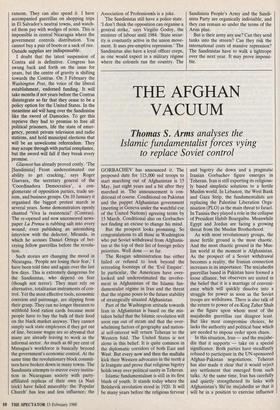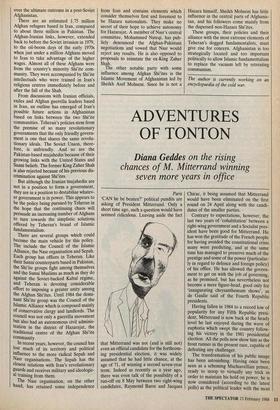THE AFGHAN VACUUM
Thomas S. Arms analyses the
Islamic fundamentalist forces vying to replace Soviet control
GORBACHEV has announced it. The proposed date for 115,000 red troops to start marching out of Afghanistan is 15 May, just eight years and a bit after they marched in. The announcement is con- ditional of course. Conditional on Pakistan and the puppet Afghanistan government (meeting in Geneva under the watchful eye of the United Nations) agreeing terms by 15 March. Conditional also on Gorbachev not finding an excuse to change his mind.
But the prospect looks promising. So congratulations to all those in Washington who put Soviet withdrawal from Afghanis- tan at the top of their list of foreign policy priorities. Well done — so far.
The Reagan administration has either failed or refused to look beyond the retreating footsteps of the 'Evil Empire'. In particular, the Americans have over- looked and underestimated the involve- ment in Afghanistan of the Islamic fun- damentalist regime in Iran and the threat that the regime poses to the future stability of strategically situated Afghanistan.
Part of the Washington attitude towards Iran in Afghanistan is based on the mis- taken belief that the Islamic revolution will soon run out of steam and that the over- whelming factors of geography and nation- al self-interest will return Teheran to the Western fold. The United States is not alone in this belief. It is quite common in the diplomatic corridors of both East and West. But every now and then the mullahs kick their Western advocates in the teeth la Irangate and prove that religious bigotry holds sway over political sanity in Teheran.
Islamic fundamentalism is still in its first blush of youth. It stands today where the Bolshevik revolution stood in 1920. It will be many years before the religious fervour and bigotry die down and a pragmatic Iranian Gorbachev figure emerges in Teheran. Iran is still exporting its religious- ly based simplistic solutions to a fertile Muslim world. In Lebanon, the West Bank and Gaza Strip, the fundamentalists are replacing the Palestine Liberation Orga- nisation (PLO) as the main threat to Israel. In Tunisia they played a role in the collapse of President Habib Bourguiba. Meanwhile Egypt and Jordan are facing a growing threat from the Muslim Brotherhood.
As with most revolutionary groups, the most fertile ground is the most chaotic. And the most chaotic ground in the Mus- lim world at the moment is Afghanistan. As the prospect of a Soviet withdrawal becomes a reality, the Iranian connection increases in its importance. The mujahedin guerrillas based in Pakistan have formed a loose alliance, but observers are united in the belief that it is a marriage of conveni- ence which will quickly dissolve into a struggle for power as soon as the Soviet troops are withdrawn. There is also talk of the return to power of ex-King Zaher Shah as the figure upon whom most of the mujahedin guerrillas can disagree least. But like most compromise choices, he lacks the authority and political base which are needed to impose order upon chaos.
In this situation, Iran — and the mujahe- din that it supports — take on a special significance. Both parties have steadfastly refused to participate in the UN-sponsored Afghan-Pakistan negotiations. Teheran has also made it clear that it would reject any settlement that emerged from such talks. At the same time, Iran has carefully and quietly strengthened its links with Afghanistan's Shi'ite mujahedin so that it will be in a position to exercise influence over the ultimate outcome in a post-Soviet Afghanistan.
There are an estimated 1:75 million Afghan refugees based in Iran, compared to about three million in Pakistan. The Afghan-Iranian links, however, extended back to before the Soviet invasion in 1979, to the oil-boom days of the early 1970s when just under a million Afghans moved to Iran to take advantage of the higher wages. Almost all of these Afghans were from the country's minority Shi'ite com- munity. They were accompanied by Shi'ite intellectuals who were trained in Iran's religious centres immediately before and after the fall of the Shah.
From discussions with Iranian officials, exiles and Afghan guerrilla leaders based in Iran, an outline has emerged of Iran's possible future actions in Afghanistan based on links between the two Shi'ite communities. Teheran's policies stem from the premise of so many revolutionary governments that the only friendly govern- ment is one that shares the same revolu- tionary ideals. The Soviet Union, there- fore, is unfriendly. And so are the Pakistan-based mujahedin because of their growing links with the United States and Sunni beliefs. The former King Zaher Shah is also rejected because of his previous dis- crimination against Shi'ites. But although the Iranian 'mujahedin are not in a position to form a government, they are in a position to destabilise whatev- er government is in power. This appears to be the policy being pursued by Teheran in the hope that the continuing chaos will persuade an increasing number of Afghans to turn towards the simplistic solutions offered by Teheran's brand of Islamic fundamentalism.
There are several groups which could become the main vehicle for this policy. The include the Council of the Islamic Alliance, the Nasr organisation and Sepah. Each group has offices in Teheran. Like their Sunni counterparts based in Pakistan, the Shi'ite groups fight among themselves and the Sunni Muslims as much as they do against the Soviet-backed Kabul regime, and Teheran is devoting considerable effort to imposing a greater unity among the Afghan Shi'ites. Until 1984 the domi- nant Shi'ite group was the Council of the Islamic Alliance which is composed mainly of conservative clergy and landlords. The council was not only a guerrilla movement but also had an autonomous civil adminis- tration in the district of Hazarajat, the traditional centre of the Afghan Shi'ite community. In recent years, however, the council has lost much of its territory and political influence to the more radical Sepah and Nasr organisations. The Sepah has the closest relations with Iran's revolutionary guards and receives military and ideologic- al training from them. The Nasr organisation, on the other hand, has retained some independence from Iran and cbntains elements ,which consider themselves first and foremost to be Hazara nationalists. They make no secret of their hope to achieve autonomy for Hazarajat. A member of Nasr's central committee, Mohammed Nateqi, has pub- licly denounced the Afghan-Pakistani negotiations and vowed that Nasr would reject any results. He is also opposed to proposals to reinstate the ex-King Zaher Shah.
The other notable party with some influence among Afghan Shi'ites is the Islamic Movement of. Afghanistan led by Sheikh Asef Mohseni. Since he is not a Hazara himself, Sheikh Mohseni has little influence in the central parts of Afghanis- tan, and his followers come mainly from the dispersed non-Hazara Shi'ites.
These groups, their policies and their alliance with the most extreme elements of Teheran's dogged fundamentalists, must give rise for concern. Afghanistan is too strategically located and too important politically to allow Islamic fundamentalism to replace the vacuum left by retreating communism.
The author is currently working on an encyclopaedia of the cold war.



























































 Previous page
Previous page